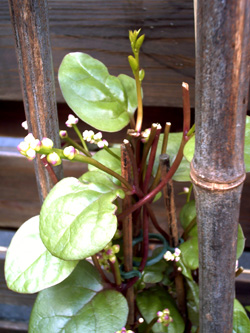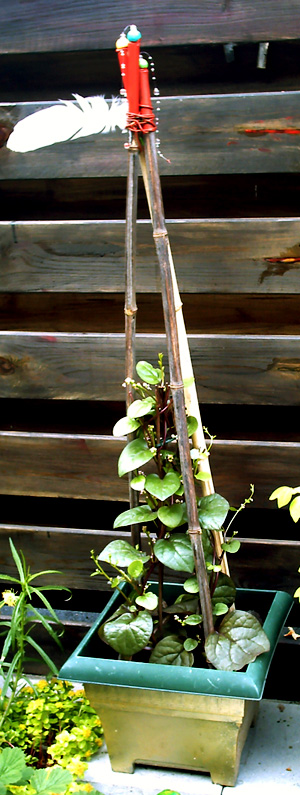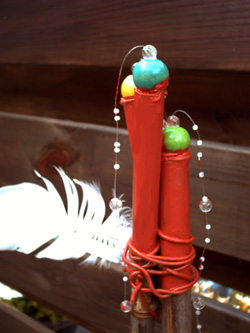Because of an very old plant dying I wanted to buy a new one for the living room.
When looking through all the beauty of ‘Basic Flowers’ at Burg. Van Stamplein in Hoofddorp, there she was. Immediate attraction and I bought her. Info said it is climbing and making red berry’s with which one can color food red. Today when I went back to look again what the name was a man also came looking at the beauty and asked me if this was eatable. Because I was not sure I said no. Coming home I looked up the beauty Basella Alba because that question of the man stirred the pot, look what I found:
http://www.survivalfoodplants.com/malabar-indian-spinach-basella-alba/
So the man was right when assuming this was eatable.Called the shop to tell them but they are cautious “…because imagine a customer will die on one of our plants….” he laughed.I could not find anything die-able about this plant.
Medicinal use:
Basella alba has been used for many of its useful product from ancient times. Nowadays its roperties have been utilized for the extraction of some useful material so that it can be used for the beneficial human activities. Some of the uses of this plant parts in the cure of certain problems occurred to humans has been explained here: Daily consumption of Basella alba has a positive effect on total-body vitamin A stores in men. The paste of root of red B. alba along with rice washed water is taken in the morning in empty stomach for one month to cure irregular periods by the rural people of Orissa, India. Leaves of B. alba is used for the treatment of hypertension by Nigerians in Lagos, and malaria in cameroonian folk medicine. The plant has been reported for its antifungal, anticonvulsant, analgesic, anti-inflammatory and androgenic activities and for the treatment of anemia. The leaves of B. alba are traditionally used in ayurveda system of medicine to bring sound refreshing sleep when it is applied on head about half an hour before bathing. A paste of the root is applied to swellings and is also used as a rubefacient. Sap is applied to acne eruptions to reduce inflammation. Decoction of leaves used for its mild laxative effects. Pulped leaves applied to boils and ulcers to hasten suppuration. Sugared juice of leaves is useful for catarrhal afflictions. Leaf-juice mixed with butter, is soothing and cooling when applied to burns and scalds. In Ayurveda, it is used for hemorrhages, skin diseases, sexual weakness, ulcers and as laxative in children and pregnant women. The plant is febrifuge, its juice is a safe aperients for pregnant women and a decoction has been used to alleviate labour. It is also an astringent and the cooked roots are used in the treatment of diarrhea. The leaf juice is a demulcent, used in cases of dysentery. This plant serves as a Thai traditional vegetable. The fruit provides dark violet color for food colorant. Basella mucilage has been used in Thai traditional medicine as topical application for irritant, bruise, ringworm and laboring. Stem and leaves are used as mild laxative, diuretic and antipyretic. In India, it has been used for antipruritis and burn, and has been used in Bangladesh for acne and freckle treatment. The Ayurvedic treatment in India has been used B. alba leaves and stem for anticancer such as melanoma, leukemia and oral cancer. Root and leaves has been used for the removal of after birth, stomach pains and increase milk production. Basella alba is administered orally for the treatment of anal prolapsed or hernia. Ground leaves of Basella alba are rubbed on the human hand to introduce the whole preparation into the animal vagina every morning for the treatment of sterility.The leaf juice is used in Nepal to treat dysentery, catarrh and applied externally to treat boils. The mucilaginous qualities of the plant make it an excellent thickening agent in soups, stews, etc. The purplish sap from fruits is used as a colouring agent in pasteries and sweets.Basella alba has been used for the treatment of Anemia in women, coughs, cold (leaf with stem), cold related infections.Maceration is taken orally for infertility, pelvic inflammatory disease, orchitis,epididymytis, threatened abortion, spurious labor. Leaves are used in constipation, poultice for sores, urticaria and gonorrhea. It is also used in poultice local swellings, intestinal complaints etc. The mucilaginous liquid obtained from the leaves and tender stalks of plants is popular remedy for headaches.
So I bought one hell of a healthy plant. I build something around her to climb further and it is all symbolic. The 3 in 1, tipi-like thing with the red colored plant like kundalini energy up the spine. Of course this is no plant for the living room and now beautifying my garden.


